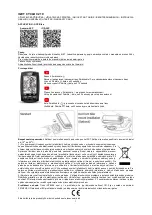
Hyperion Optical Sensors - Operating Manual:
MANUAL-1013637447-3 | issue: 1.6
Page | 7
©
2022
– Valeport Ltd
2.3 Quenching
Quenching refers to the reduction in fluorescence of a fluorophore. Several processes can result in
quenching:
Chloride is known to quench quinine sulphate and Fluorescein. It is, therefore, advisable to prepare
any fluorophore solutions with RO* or DI** water.
Temperature quenching - as the temperature of the sample increases, the fluorescence decreases,
that is, fluorescence is sensitive to temperature. In order to improve accuracy, measure the
sample at different temperatures and derive corrections for changes in temperature.
Photo-bleaching (or fading) is the (permanent) degradation of a fluorophore molecule by light
resulting in lower signal levels. Photo-bleaching is dependent on exposure (intensity of light and
duration) and wavelength (UV is more damaging than longer wavelengths). Use of more robust
fluorophores is recommended to avoid photo-bleaching.
* Reverse Osmosis
** De-Ionised








































